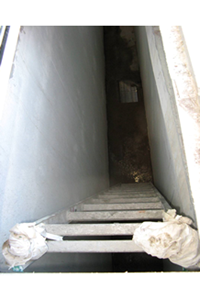Worker fell into unguarded vertical shaft
Date of incident: April 2015
Notice of incident number: 2015165410475
Employer: Construction labour supply company
Incident summary
The jobsite was a concrete highrise building under construction. Two workers were cleaning out debris in an air vent shaft approximately 10 feet (3 metres) below grade. The horizontal shaft was about 168 feet (51 metres) long and was unlit. Access was via a 10‑foot aluminum ladder. One worker, who was working about halfway down the length of the shaft, walked off the edge of the horizontal shaft and into an unguarded vertical air shaft. The worker fell approximately 30 feet (9 metres), landing on the concrete below. The worker sustained fatal injuries.
Investigation conclusions
Cause
- Lack of an appropriate fall protection system: The direct cause of this incident was fall from elevation due to a lack of a fall protection system. The hierarchy of fall protection was not followed, and this led to the worker falling down a vertical air shaft and sustaining fatal injuries. The metal grates — acting as guards — covering the access to the horizontal shaft had been temporarily removed to accommodate the work. As a result, the horizontal shaft, where the work was taking place, was now open and leading to the unguarded vertical shaft.
Underlying factors
- Inadequate risk assessment: No one did a complete risk assessment, which would have determined that there was a fall hazard due to the open and unguarded vertical shaft. Site drawings could have been reviewed to establish the location of potential hazards but were not. An inspection of the work area only included a visual view from the ground level into the shaft. This superficial examination, therefore, did not take into account the danger that existed and was directly connected to this horizontal shaft.
- Ineffective safe work procedure: The safe work procedure (SWP) that was developed as a result of the inadequate risk assessment indicated a potential need for rescue. Nonetheless, even though the worker was wearing a harness and lanyard, it was not connected to an anchor. There was no discussion of coordination for rescue or the required equipment. The SWP also acknowledged fall hazards but did not describe what those hazards were or how they would be prevented. Entry to the vertical shaft was not restricted. There was no adequate safeguard and no signage to warn of the danger, and no lighting was provided to the worker so that he could see the danger. Despite the contention by the prime contractor that the area to be cleaned was limited to a small, lighted work area, this was communicated neither in the SWP nor verbally to the workers, and they assumed they were to clean the entire length of the shaft.
- Lack of communication: Although many people on this jobsite were aware of the connection of the horizontal shaft to the vertical shaft, the worker involved in the incident had not been told about it. It is likely that if he had known the vertical shaft was there, he would not have moved toward it.
- Inadequate supervision: The workers involved in the cleanup job were left unsupervised when both the superintendent and the foreman left the jobsite for the day. The foreman considered one of the workers to be his lead hand although that worker was not trained or hired for that role.
- Inadequate planning: The development of the SWP and the setup for the task of cleaning out the horizontal shaft only occurred the morning of the incident. The SWP was completed at about 09:30, but the job didn’t get started until almost four hours later. Had the task been discussed during the morning site meeting, it’s possible that the superintendent would have reminded the foreman of the open vertical shaft.
Related resource:
Worker Falls Down Vent Shaft (Slide show)

